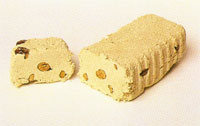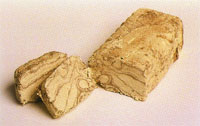

 |
By the
time people in the palace of the
ancient Mycaeneans finally developed
interest in "sa-sa-ma" - writing
tablets listing deliveries of
supplies also give an abbreviated
form of the word as "sa" - (sesame)
in 1500 B.C., the sesame plant had
already been in use in East Africa
and India for about 500 years.
The plant had been deliberately
cultivated there and the nutritious
aromatic sesame seeds were highly
prized. Around 600 B.C., the
Greeks discovered that sesame seeds
were perfect for flavoring bread:
"Seven couches and as many tablets,
crowned with poppy seed, linseed and
sesame seed bread, and for the
girls, buckets of a sweet
dessert...this a sweet
mixture of honey and linseed,"
enthuses Athenaeus in his book
Deipnosophistae ("The Banquet of the
Learned" or "The Gastronomers"),
providing unequivocally that not
only sesame seed bread, but also
tasty combinations of plant seeds
and honey, for instance, were
extremely popular at the time. The
list of household goods belonging to a rich
Athenian whose possessions were to be
auctioned included sesame seeds, alongside
such mundane items as olive oil, lentils,
and grain.And the poet Antiphanes from
the 4th century B.C. also lists
sesame seeds along with caraway
marjoram, and thyme in his list of
spices.
|
But is was to be centuries before Greece
eventually produced the most delicious and
healthiest sweet confectionery of all:
halvas, halva. in northern Greece, halvas
is served for breakfast on account of its
nutritional value, as well as for dessert
along with a glass of wine. Halvas
consists of 50 percent milled and toasted
sesame seeds (takhini) and a warmed mixture
of sugar and glucose. It is now
possible to replace the sugar content with
honey or fructose so that even diabetics may
enjoy halvas. The sesame paste is
mixed with sugar or honey until it forms a
solid mass. This is left to cool and
harden. Before it sets completely, the
paste is put into different sized molds.
Halvas sets at 59 degree F (15 degree C).
Cocoa, peanuts, pistachios, almonds, or
candied fruit, as well as oil of roses may
be added to produce a variety of flavors.
Its appearance can also be varied by molding
it into various shapes or coating it with
chocolate. Halvas is particularly
popular with Greeks during Lent since it is
thankfully not prohibited. Because of
its high content of fat, calcium, iron,
phosphorus, protiens, and vitamins A and C,
it is a long-lasting and nutritious source
of energy and is also believed to rejuvenate
the cells of the body.
|